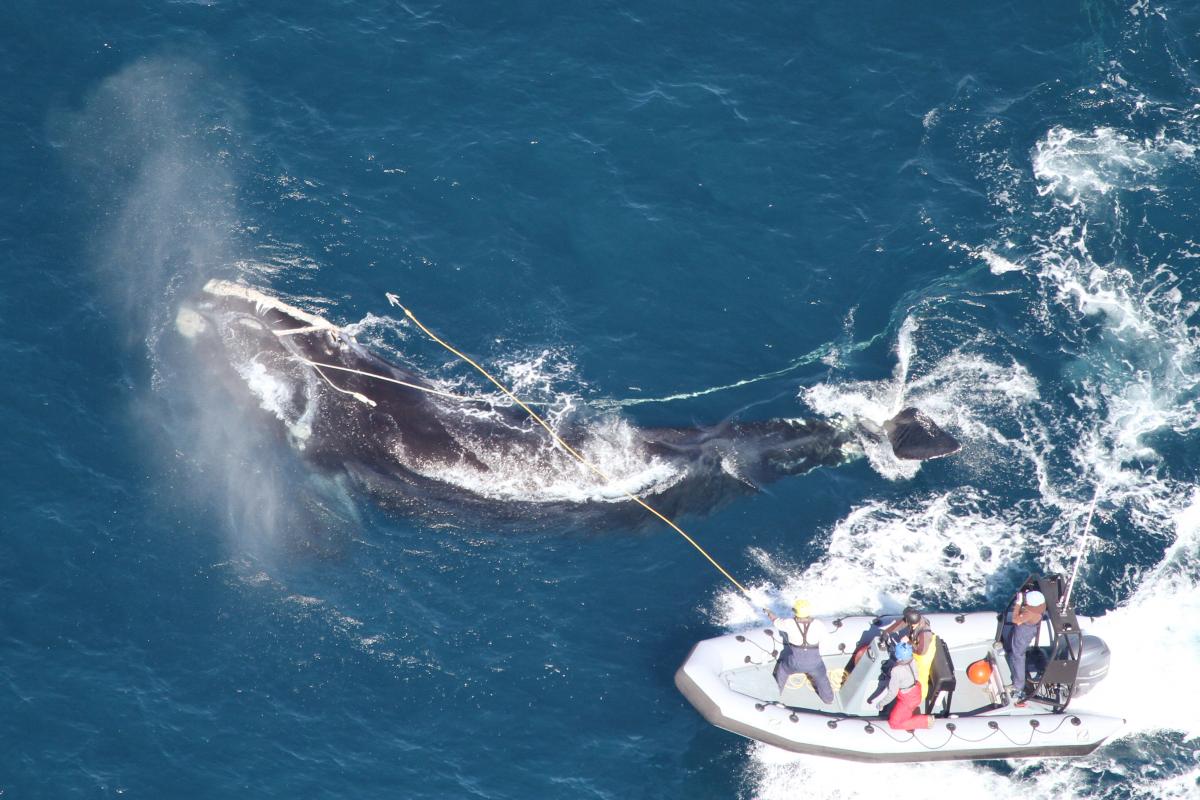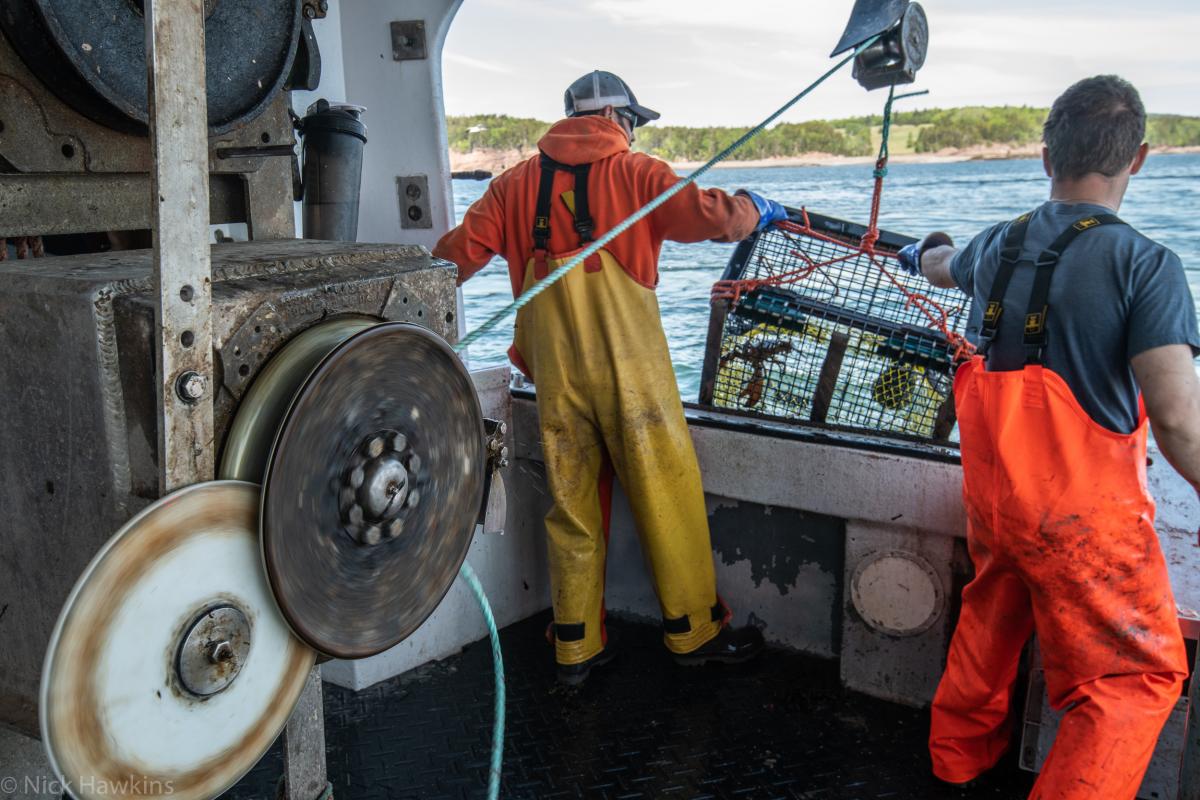December 13, 2019
North Atlantic right whales are on a course to extinction
Estimated reading time: 0 minutes
BY: Oceana
Punctuation, a North Atlantic right whale named for the comma-like scars on her head, was a mother to eight and a grandmother to two. She was at least 38 years old, judging from when researchers first sighted her in 1981. In June, the prolific mother was feeding in Canada’s Gulf of St. Lawrence when a ship slammed into her enormous body, leaving a 6-foot gash along her spine that cut so deep her organs spilled out.
Before her death, Punctuation was one of the rarest of beasts. There are only around 360 North Atlantic right whales left on earth, and fewer than 100 breeding females. Punctuation’s death, a severe blow to a species in desperate need of new members, was one of 10 this year. Two others died, like her, from ship collisions.
The summer’s deaths sent chills through the right whale scientific community. Updated rules following the carnage of 2017, when at least 17 whales perished, were supposed to buffer these slow-moving leviathans from entangling fishing gear and passing ships. Last year brought three deaths, followed by the mounting misfortunes of 2019. The recent mortalities make it clear that current measures aren’t enough to protect the whales. Now, Oceana’s teams in Canada and the United States are uniting to launch a campaign to save a species on the edge of extinction.
A tangle with death
Nine thousand to 21,000 North Atlantic right whales once roamed the Atlantic in a vast arc from Bermuda through Canada and Norway, and south to northwestern Africa. They’re sometimes called the “urban whale,” and for good reason: Their travels put them in the paths of some of North America’s busiest shipping lanes and fishing zones.
Centuries of commercial whaling decimated them, possibly leaving only 100 individuals alive, before the League of Nations outlawed right whale hunting globally in 1935. North Atlantic right whales recovered, albeit at a glacial pace, peaking at almost 500 individuals in the early 2000s. But it wasn’t long before the whales started vanishing once more.
Punctuation’s life and death offer a worrying clue as to why. Before her fatal collision in June, she had been struck twice by ships, but survived, and had also been entangled in fishing gear at least five times before managing to escape.
Her harrowing story is far too common. Nearly 83% of North Atlantic right whales bear scars from tangles with fishing gear, and nearly 60% have been snared more than once. The whales are strong, but fishing gear is stronger. Heavy nylon buoy ropes are nearly indestructible, and they’re attached to clusters of lobster or crab traps that can weigh hundreds to tens of thousands of pounds. This gear can loop around whales’ mouths and starve them, slowly slice off fins, or drown or fatally exhaust them over the course of months.
A July study found that entanglements and ship strikes caused nearly 90% of the deaths of 43 right whales whose necropsies revealed a clear cause of mortality. “We’re not even seeing them die from natural causes anymore,” said Whitney Webber, the head of Oceana’s right whale campaign in the U.S.

Responders from the Florida Fish and Wildlife Conservation Commission and the Georgia Department of Natural Resources toss a grapple in an attempt to cut the fishing rope that can be seen dangling from the right whale’s mouth. The rescue was successful, and the whale was freed. Photo Credit: Florida Fish and Wildlife Conservation Commission
Gulf of St. Lawrence tragedies
After 2017’s “unusual mortality event,” the Canadian government beefed up protections for the whales. The government created a “static zone” that prohibits the use of lobster and crab lines and other types of fishing gear that entangle whales, along with “dynamic zones,” where all fishing gear has to be removed if a whale is spotted in the area. The government also implemented speed reduction zones in the Western Gulf of St. Lawrence for ships 20 meters and longer, and reduced that size to 13 meters after several whales were found dead in shipping lanes in June.
For Kim Elmslie, director of Oceana Canada’s right whale campaign, these measures aren’t enough. The dynamic zones rely on aerial monitoring, but airplanes can’t spot whales if it’s foggy, stormy or nighttime. Many whales go unseen. And in 2019, the government reduced the no-fishing zone by 63%, on the assumption that whales would only return to the same areas they had visited in previous years.
“To be effective the fishing and shipping measures must be created using all information on whale sighting as well as modeling that tries to predict where the whales will be found in the future,” Elmslie said.
There is an extra level of danger in assuming that whales will continue to return to the same areas year over year, Elmslie added. The whales’ prey – cold-loving plankton called copepods – are shifting unpredictably as climate change heats up the ocean.
And where the copepods go, whales follow. While North Atlantic right whales once fed in large numbers in the Bay of Fundy, many are now traveling to the Gulf of St. Lawrence, a busy shipping and fishing zone where the majority of 2017 and 2019’s known deaths were discovered.
The U.S. is falling behind, too. “We have very insufficient protective measures right now for these whales,” Webber said. She noted that because most whales are dying in Canada, some fishing interests in the U.S. are resisting efforts to cut down on whale-entangling gear, and their resistance is in part translating to slow regulatory action.
Vanishing act
Oceana’s Canada and U.S. teams are now joining forces to push their governments towards stricter protections including effective management areas, mandatory speed reductions for ships and improved monitoring.
Limiting the number of vertical fishing lines in the Atlantic, promoting the development of whale-safe fishing gear and strategically closing fisheries when needed would greatly improve right whales’ chances of survival. Both teams are also advocating for improved satellite tracking of fishing vessels to determine where boats and whales are getting too close for comfort.

Heavy ropes attached to lobster traps can ensnare whales. Roughly 1 million fishing lines sprawl across right whale migration routes and feeding areas in the U.S. and Canada. Photo Credit: Nick Hawkins
The U.S. team is fighting another threat, too. President Trump has proposed opening nearly all U.S. waters to offshore drilling, and in 2018, the administration authorized five companies to harm marine mammals hundreds of thousands of times while conducting large-scale seismic surveys for oil and gas in the Atlantic.
Seismic airgun blasting, which creates one of the loudest manmade sounds in the ocean, uses compressed air explosions to search for potential oil and gas deposits buried beneath the seafloor. These deafening blasts interfere with right whale communication, including between mother and calf, and ramp up stress. Oceana and its partners are challenging the permits in court, and have created a groundswell of opposition to offshore drilling and seismic airgun blasting along the east and west coasts of the U.S.
Oceana’s efforts in the U.S. and Canada are a race against time. Though seven calves were born in the 2018-2019 calving season – a big improvement from the previous season’s zero births – it’s not enough. “They’re dying much more quickly than they’re reproducing,” Webber said. “We’re looking at functional extinction in the next couple of decades.”
If North Atlantic right whales go extinct, they’d be the first large whale to vanish in centuries in the Atlantic Ocean. Letting the whales slip through our fingers would be “catastrophic,” Webber said. “And that’s why Oceana is stepping up.”
Join Oceana in helping to protect North Atlantic Right Whales
This story appears in the current issue of Oceana Magazine. Read it online here.

